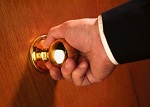When people find out I’m a Feng Shui consultant, I’ll often hear, “I know you are supposed to paint your front door red.” And it’s true. Or not. Depending.
Confused? Don’t be. The origins of this statement come from the belief that your front door is your “calling card” to the world. Red became associated with it because it is said to be an auspicious color. So, if you love that color, then yes, paint your door red! If red’s not your thing, then don’t. Pick a color that you love and that makes you happy.
In Feng Shui we associate front doors with new opportunities. Front doors are the “mouths of chi” where energy enters your home. Because they are about opportunities, the front door is related to careers as well.
If you are looking for a new career opportunity or to ramp up your career, this is the place to start. What is happening at your front door? (Inside and outside!) What is your message to the world?
Make sure:
- It’s welcoming. Paint your front door a color you love that stands out from the rest of the house. Check your house numbers. Add flowers.
- It’s clear of clutter to allow new opportunities to come in.
- Everything around there is alive. Remove any dead plants that were left out over the winter if they won’t re-bloom in the spring. It’s better to have an empty pot (at least there’s potential there).
- You have a place for your “things.” You may not want all the shoes to pile there, but if they do, have a place for them. Figure out a system so it doesn’t look like chaos.
- You use your front door at least weekly. (Yes, even if you have an attached garage!) You will see your house in a whole new perspective.
Whether your front door is red, yellow or blue (or any other color for that matter), have it send the message that you invite opportunities. At the very least, if it’s a color you love, it will put a smile on your face. And that is good energy.










Recent Comments